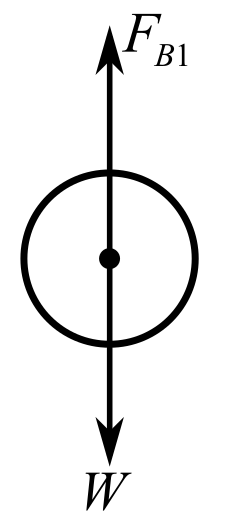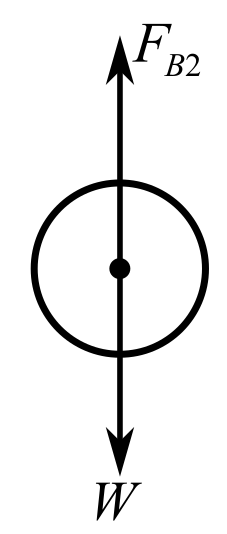
Concept explainers
Determine the unbalanced force acting on an iron ball
(a)
The unbalanced force and the initial acceleration of the iron ball when it is just released while totally immersed in water if
Answer to Problem 54SP
Solution:
Explanation of Solution
Given data:
The density of the iron ball is
The radius of the iron ball is
Formula used:
The volume of a sphere is expressed as,
Here,
The density of a body is calculated by the formula,
Here,
Archimedes’ principle states that the apparent upward force experienced by the solid immersed in a fluid is equal to the weight of the fluid displaced by it. This upward buoyant force on the solid is expressed as,
Here,
The weight of a body is expressed as,
Here,
Newton’s second law for a body is expressed as,
Here,
Explanation:
Draw a free body diagram for the iron ball when the ball is submerged in water.

Here,
Understand that the ball is in the shape of a sphere. Recall the formula for the volume of a sphere to calculate the volume of the iron ball.
Substitute
Recall the formula for the density of the iron ball.
Substitute
Recall the formula for the weight of the iron ball.
The standard value of acceleration due to gravity is
Understand that the ball is completely submerged in water. Therefore, write the expression for the volume of a ball submerged in water.
Substitute
Recall the expression for the buoyant force exerted by water on the iron ball.
Here,
The standard value of
Write the expression for net force on the ball along the vertical direction by taking the upward force as positive and the downward force as negative.
Substitute
Here, the negative sign indicates that the force acts in the downward direction.
Therefore, the force on the iron ball when it is just released while immersed in water is
Recall the expression for Newton’s second law in terms of net force.
Substitute
Further solve as,
Here, the negative sign indicates that the acceleration acts in the downward direction.
Conclusion:
The net force on the iron ball when it is just released while immersed in water is
(b)
The unbalanced force and the initial acceleration of the iron ball with
Answer to Problem 54SP
Solution:
Explanation of Solution
Given data:
The density of the iron ball is
The radius of the iron ball is
The density of mercury is
Formula used:
Archimedes’ principle states that the apparent upward force experienced by the solid immersed in a fluid is equal to the weight of the fluid displaced by it. This upward buoyant force on the solid is expressed as,
Here,
The expression of Newton’s second law for a body is expressed as,
Here,
Explanation:
Draw a free body diagram for the iron ball when the ball is submerged in mercury.

Here,
Understand that the ball is completely submerged in mercury. Therefore, write the expression for the volume of a ball submerged in mercury. Hence,
Substitute
Recall the expression for buoyant force exerted by mercury on the iron ball.
Here,
Consider, the standard value of
Substitute
Write the expression for the net force on the ball in the vertical direction by taking the upward force as positive and the downward force as negative.
Substitute
Here, the positive sign indicates that the force acts in the upward direction.
Therefore, the force on the iron ball when it is just released while immersed in mercury is
Recall the expression for Newton’s second law for acceleration in terms of net force.
Substitute
Further solve as,
Here, the positive sign indicates that the acceleration acts in the upward direction.
Conclusion:
The net force on the iron ball when it is just released while immersed in mercury is
Want to see more full solutions like this?
Chapter 13 Solutions
Schaum's Outline of College Physics, Twelfth Edition (Schaum's Outlines)
- A person of mass m stands on a rope ladder that is hanging from a freely floating balloon of mass M. The balloon is initially at rest with respect to the ground. (The buoyant force on the personballoon system is countering the force of gravity.) a. In what direction will the balloon move if the person starts to climb the rope ladder at constant velocity v relative to the ladder? b. At what speed will the balloon move if the person starts to climb the rope ladder at constant velocity v relative to the ladder?arrow_forwardShow that the Reynolds number NRis unitless by substituting units for all the quantities in its definition and cancelling.arrow_forwardA spherical vessel used for deep-sea exploration has a radius of 1.50 m and a mass of 1.20 104 kg. To dive, the vessel takes oil mass in the form of seawater. Determine the mass the vessel must take on if it is to descend at a constant speed of 1.20 m/s, when the resistive force on it is 1 100 N in the upward direction. The density of seawater is equal to 1.03 103 kg/m3.arrow_forward
- An object is released from rest while immersed within a fluid. The terminal speed of the object is measured to be 8.34 m/s. What was the speed of the object 1.551 s after being released? Let the resistive force be given by R = -bv (Assume that the gravitational force also acts)arrow_forwardYour mission is to determing the value of gravity g for an unknown planet. To do this you have a tank with a maximum height of 4.00 m and a fluid with a density of 1200 kg/m3. A pressure gauge at the bottom of the tank measures a gauge pressure of 21.8 kPa. What is the gravity g? Assume 3 significant digits. A. 2.27 m/s2 B. 4.54 x10-3 m/s2 C. 2.27 x10-3 m/s2 D. 5.45 x10-3 m/s2 E. 5.45 m/s2 F. 45.4 m/s2 G. 22.7 m/s2 H. 4.54 m/s2arrow_forwardYou are preparing some apparatus for a visit to a newly discovered planet Caasi having oceans of glycerine and a surface acceleration due to gravity of 5.40 m/s2. If your apparatus floats in the oceans on earth with 25.0 % of its volume submerged, what percentage will be submerged in the glycerine oceans of Caasi? [20.4 %]arrow_forward
- Archimedes' thrust is the vertical force oriented upwards experienced by a body immersed in a liquid (allowing it to float). This force corresponds to the weight of the volume of the displaced liquid. For example, a object immersed in water (density 1000 kg / m3 ) will undergo a flare of Archimedes of 9810 N for each cubic meter of its submerged volume (i.e. 9, 81 m / s2 1000 kg / m3 1 m3 = 9810 N). A buoy is made from a steel tube 4 meters long and 0.5 radius meter to which we welded a half-sphere at each end. Knowing that the weight of the buoy is 3630 N say what will be the immersion height of this buoy if it is submerged in fresh water (density 1000 kg / m3 ).arrow_forwardThe terminal velocity of a copper of ball 2 milimiter falling through a tank of oil is 6.5cm/s . Determine the viscocity of oil if it's density is 1.5×103and the density of copper is 8.9*103kg/m3arrow_forwardAn airplane has wings, each with area 3.85 m2, designed so that air flows over the top of the wing at 248 m/s and underneath the wing at 226 m/s. Approximately what size wings would an aircraft need on Mars if its engine generates the same differences in speed as in the "Practice It" and the total mass of the craft is 300 kg? The density of air on the surface of Mars is approximately one percent Earth's density at sea level, and the acceleration of gravity on the surface of Mars is about 3.8 m/s2. ______________m2arrow_forward
- A fluid that occupies a volume of A Liter weighs B N at a location where the gravitational acceleration is 9.80 m/s2 A = 4.5 liters B = 15 N Mass of this fluid (kg) is _________. Density (kg/L) of fluid is ________.arrow_forwardAn object of volume 2.00 m^3 is fully submerged in water ( ?water=1000.00 kg/m^3 ). In order to keep the object stationary, an upward force of 7600.00N must be applied to keep the object from sinking. Determine the density of the object. a. 612.24 kg/ m^3 b. 19600.00 kg /m^3 c. 387.76 kg /m^3 d. 12000.00 kg/ m^3 e. 1387.76 kg/ m^3arrow_forward
 College PhysicsPhysicsISBN:9781285737027Author:Raymond A. Serway, Chris VuillePublisher:Cengage Learning
College PhysicsPhysicsISBN:9781285737027Author:Raymond A. Serway, Chris VuillePublisher:Cengage Learning Principles of Physics: A Calculus-Based TextPhysicsISBN:9781133104261Author:Raymond A. Serway, John W. JewettPublisher:Cengage Learning
Principles of Physics: A Calculus-Based TextPhysicsISBN:9781133104261Author:Raymond A. Serway, John W. JewettPublisher:Cengage Learning Physics for Scientists and Engineers: Foundations...PhysicsISBN:9781133939146Author:Katz, Debora M.Publisher:Cengage Learning
Physics for Scientists and Engineers: Foundations...PhysicsISBN:9781133939146Author:Katz, Debora M.Publisher:Cengage Learning Physics for Scientists and Engineers, Technology ...PhysicsISBN:9781305116399Author:Raymond A. Serway, John W. JewettPublisher:Cengage Learning
Physics for Scientists and Engineers, Technology ...PhysicsISBN:9781305116399Author:Raymond A. Serway, John W. JewettPublisher:Cengage Learning College PhysicsPhysicsISBN:9781938168000Author:Paul Peter Urone, Roger HinrichsPublisher:OpenStax College
College PhysicsPhysicsISBN:9781938168000Author:Paul Peter Urone, Roger HinrichsPublisher:OpenStax College




